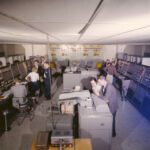
It’s not unusual to hear that a particular military technology has found its way into other applications, which then revolutionized our lives. From the imaging sensors that were refined to fly on spy satellites to advanced aerodynamics used on every modern jetliner, many of these ideas initially sounded like bad science fiction.
So did this one.
Consider the following scenario:
To defend the United States and Canada, a massive array of interconnected radars would be set up across the two nations. Connected by high-speed links to a distributed network of computers and radar scopes, Air Force personnel scan the skies for unexpected activity. One day, an unidentified aircraft is discovered, flying over the Arctic and heading toward the United States. A quick check of all known commercial flights rules out a planeload of holiday travelers lost over the Northern Canadian tundra. At headquarters, the flight is designated as a bogey, as all attempts to contact it have failed. A routine and usually uneventful intercept will therefore fly alongside to identify the aircraft and record registration information.
Before the intercept can be completed, more aircraft appear over the Arctic; an attack is originating from Russia. Readiness is raised to DEFCON 2, one step below that of nuclear war. Controllers across the country begin to get a high-level picture of the attack, which is projected on a large screen for senior military leaders. At a console, the intercept director clicks a few icons on his screen, assigning a fighter to its target. All the essential information is radioed directly to the aircraft’s computer, without talking to the pilot.
By the time the pilot is buckled into his seat and taxiing to the runway, all the data needed to destroy the intruder is loaded onboard. A callout of “Dolly Sweet” from the pilot acknowledges that the data load is good. Lifting off the runway and raising the gear, a flip of a switch in the cockpit turns the flight over to the computers on the ground and the radar controllers watching the bogey. A large screen in the cockpit provides a map of the area and supplies key situational awareness of the target.
The entire intercept is flown hands-off, with the pilot only adjusting the throttle. The aircraft, updated with the latest data from ground controllers, adjusts its course to intercept the enemy bomber. Only when the target is within the fighter’s radar range does the pilot assume control—then selects a weapon and fires. After a quick evasive maneuver, control returns to the autopilot, which flies the fighter back to base.
This isn't an excerpt from a dystopian graphic novel or a cut-and-paste from a current aerospace magazine. In truth, it’s all ancient history. The system described above was called SAGE—and it was implemented in 1958.
SAGE, the Semi-Automatic Ground Environment, was the solution to the problem of defending North America from Soviet bombers during the Cold War. Air defense was largely ignored after World War II, as post-war demilitarization gave way to the explosion of the consumer economy. The test of the first Soviet atomic bomb changed that sense of complacency, and the US felt a new urgency to implement a centralized defense strategy. The expected attack scenario was waves of fast-moving bombers, but in the early 1950’s, air defense was regionally fragmented and lacked a central coordinating authority. Countless studies tried to come up with a solution, but the technology of the time simply wasn’t able to meet expectations.
Whirlwind I
In the waning days of World War II, MIT researchers tried to design a facility for the Navy that would simulate an arbitrary aircraft design in order to study its handling characteristics. Originally conceived as an analog computer, the approach was abandoned when it became clear that the device would not be fast or accurate enough for such a range of simulations.
Attention then turned to Whirlwind I, a sophisticated digital system at MIT, with a 32-bit word length, 16 “math units,” and 2,048 words of memory made from mercury delay lines. Importantly, Whirlwind I had a sophisticated I/O system; it introduced the concept of cycle stealing during I/O operations, where the CPU is halted during data transfer.
After a few years, the Navy lost interest in the project due to its high cost, but the Air Force evaluated the system for air defense. After modifying several radars in the Northeast United States to send digital coordinates of targets they were tracking, Whirlwind I proved that coordinating intercepts of bombers was practical. Key to this practicality were high-reliability vacuum tubes and the development of the first core memory. These two advances reduced the machine’s otherwise considerable downtime and increased processing soon made Whirlwind I four times faster than the original design.





































You must login or create an account to comment.